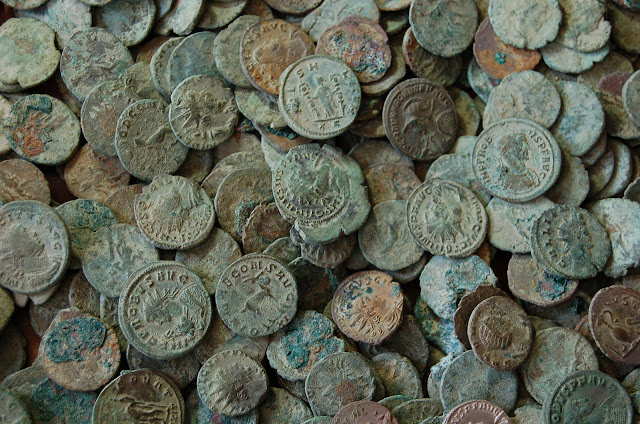The discovery of buried treasure often captivates the imagination, evoking images of pirates or ancient civilizations. While Hollywood movies may make us believe these treasures only exist in fiction, the reality is far more intriguing. One such real-life treasure is the Frome Hoard – a colossal cache of Roman coins discovered in England.
 |
| Coins from the Frome Hoard - showing a range of Emperors |
Unearthed in April 2010 by amateur metal detectorist Dave Crisp, the Frome Hoard ranks as one of the largest collections of Roman coins ever found in Britain. Concealed within a ceramic pot was an astonishing number of coins - approximately 52,503 to be precise, making this discovery a treasure not only of substantial monetary value but of priceless historical significance.
 |
| Diagram showing the Amphora in situ and the depth at which the Hoard was found. |
The coins were minted during the reign of various Roman Emperors, spanning a range of about 40 years, from AD 253 to 293. Most of the coins were issued under Carausius, a Roman military officer who declared himself Emperor of Britain and Northern Gaul after rebelling against the central Roman authorities. His reign (AD 286 to 293) represents a fascinating episode in the history of the Roman Empire, and the Frome Hoard, with a significant representation of his coinage, offers invaluable insights into this era.
The large majority of the coins in the Frome Hoard were minted during the reign of Carausius, who was an intriguing character in the annals of Roman Britain. Carausius was a Roman naval officer assigned to protect the English Channel's coasts from pirates. However, after being accused of pilfering some of the loot he recovered, Carausius declared himself Emperor of Britain and parts of Gaul. He ruled independently from AD 286 to 293, until he was assassinated by his treasurer, Allectus. His audacious break from the Roman Empire represented a significant event during the era of the Roman tetrarchy.
 |
| A rare silver Denarius of Carausius found withing the hoard. |
His coinage was central to establishing his legitimacy as a ruler. Carausius issued coins with powerful imagery and Latin inscriptions, often bearing the likenesses of revered Roman gods, aiming to parallel his rule with their divine authority. Interestingly, some coins discovered in the hoard bore the inscription "R S R," meaning "Rome’s Reason for Existing" or "Rome’s Salvation Depends on Rest," reflecting his aspiration to align his reign with Rome's restoration. Thus, the Frome Hoard, with the significant representation of Carausius's coinage, helps in understanding the politico-economic strategies employed during his rule.
The coins' denominations vary, with the majority being radiates - a type of coin that got its name from the radiate crown typically worn by the depicted Emperor. Another fascinating detail is the weight of the hoard, which amounted to around 160kg (353lbs). To imagine a single pot containing such a wealth of coins is nothing short of astounding.
One might ask: why were these coins buried? The question, however, remains a mystery. It is speculated that the cache might have been an offering to the gods – a common practice in Roman Britain during periods of upheaval or uncertainty. The sheer size of the hoard, and the fact that it remained undisturbed for more than 1700 years, reinforces this theory. It was not uncommon for individuals to bury their wealth in times of crisis, intending to retrieve it later, but the Frome Hoard's scope suggests a ritualistic or ceremonial purpose.
Upon discovery, the hoard was declared a treasure under the Treasure Act 1996. The Portable Antiquities Scheme and the British Museum collaborated in the conservation and study of the hoard, ensuring that its historical value would not be lost. The hoard now resides in the Museum of Somerset, where it serves as a spectacular testament to the county's rich Roman heritage.
The Frome Hoard discovery underlines the value of 'detectorist' enthusiasts. Their efforts often lead to the uncovering of significant historical artefacts, providing archaeologists and historians with crucial insights into the past. Despite the initial thrill of unearthing a treasure, Crisp acted responsibly, immediately reporting his findings to local archaeological authorities, thus enabling the proper excavation, conservation, and study of the hoard.
 |
| The Frome Hoard in Situ |
Although it has been more than a decade since the Frome Hoard's discovery, the archaeological and historical communities continue to study its implications. The hoard stands as a remarkable symbol of Roman influence in Britain, serving as a tangible connection to an era that shaped the world as we know it.
In essence, the story of the Frome Hoard is a compelling chapter in the historical narrative of Roman Britain. Each coin, each imprint, each Emperor's face tells a tale of its own. As a collective, they paint a vivid picture of a time past, shedding light on the socio-political climate of the era and the Roman influence that shaped Britain's destiny. For history enthusiasts, the Frome Hoard is not just a pile of ancient coins; it is a treasure trove of stories waiting to be told.
Sources:
1. Besly, E. & Bland, R. (2010). The Frome Hoard. London: British Museum Press.
2. Bland, R. (2010). "The Frome Hoard and the end of empire". British Archaeology. York: Council for British Archaeology.
3. Moorhead, S., Booth, A., & Bland, R. (2017). The Frome Hoard. In: Eckardt, H. (ed.) 50 Roman Finds From the Portable Antiquities Scheme. 50 Finds. Stroud: Amberley Publishing.
4. Reece, R. (2002). Coinage in Roman Britain. Stroud: Tempus.
5. Casey, P.J. (1994). Carausius and Allectus: The British Usurpers. London: Batsford.
6. "Frome Hoard". National Heritage List for England. Retrieved from https://historicengland.org.uk/.

Comments
Post a Comment